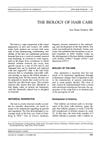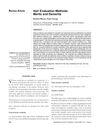TLDR Hair can help solve crimes by revealing personal and chemical information.
The document discussed the forensic significance of hair and animal fibers in investigations, highlighting their ability to provide crucial information such as species identification, chemical composition, and geographical origin. Hair analysis could reveal medical history, drug use, and toxicological data, aiding in criminal identification through microscopic, elemental, and DNA analysis. The study emphasized the role of hair in forensic science over the past 50 years, focusing on its structural components like keratin and melanin, which are essential for linking individuals to crime scenes and supporting legal investigations.
44 citations
,
November 2007 in “Journal of toxicology and environmental health. Part B, Critical reviews” Copper and zinc in hair can indicate health conditions.
199 citations
,
January 2004 in “The International Journal of Developmental Biology” Hair follicle growth and development are controlled by specific genes and molecular signals.
 72 citations
,
July 2003 in “Journal of cosmetic dermatology”
72 citations
,
July 2003 in “Journal of cosmetic dermatology” Frequent hair coloring and styling can damage hair and cause breakage or loss.
 41 citations
,
October 2000 in “Dermatologic clinics”
41 citations
,
October 2000 in “Dermatologic clinics” Better hair care products are needed to protect against grooming and chemical damage.
27 citations
,
September 1988 in “PubMed” Hair follicle shape determines hair type: curly, straight, or in-between.
 24 citations
,
July 1987 in “Dermatologic Clinics”
24 citations
,
July 1987 in “Dermatologic Clinics” Systemic diseases can cause hair loss, which is often reversible with treatment.
 91 citations
,
January 2009 in “International Journal of Trichology”
91 citations
,
January 2009 in “International Journal of Trichology” Different hair evaluation methods have their own pros and cons, and using multiple methods together is best for accurate hair loss diagnosis and tracking.




